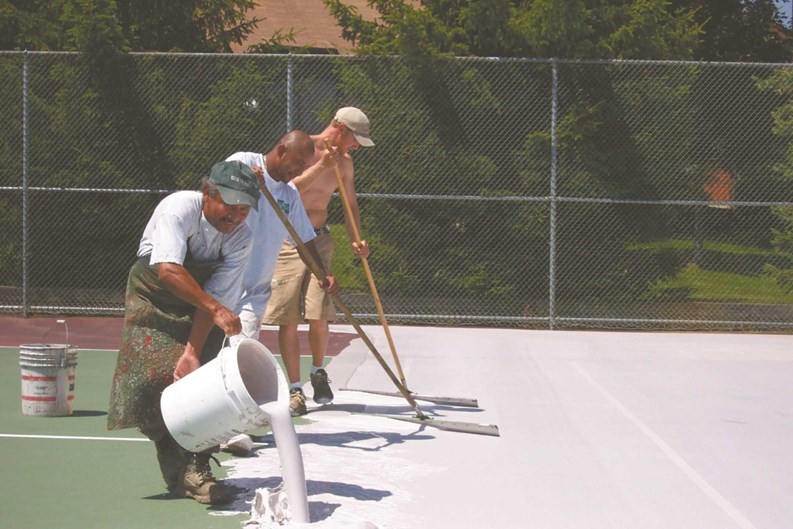Outdoor amenities like tennis courts, golf courses, playgrounds and pools are valuable assets for any HOA, but they require a significant commitment when it comes to maintenance and upkeep. With summer on the way, the weather is warming up and people are taking to the outdoors. Now is the time to get outside and check out your equipment to make sure all is in good working order, winter wear-and-tear repaired, and worn-out or obsolete items are replaced or upgraded.
Perfect Playgrounds
Each year, thousands of children are injured on the playground. We’re not just talking skinned knees and bruised elbows either. Children can get burned from hot playground surfaces, choked from catching loose clothing on playground equipment and injured from loose playground parts. The National Program for Playground Safety declared April 19th to April 25th National Playground Safety Week and suggests that homeowners, associations and towns use this time to inspect and repair safety equipment.
Andrew Oliver of Superior Play Systems in Bear, Delaware (with additional offices in Mount Laurel, New Jersey) suggests that associations take this one step further and check over playground equipment on a continuous basis.
“The main times for residential playgrounds are [every] six to eight months, at the change of the seasons from cold to warm and then again before the cold,” says Oliver. “The redwood and red/cedar systems we sell are designed to be re-tightened periodically, and the lumber holds its shape to reduce the amount of wear and tear over the years.”
In order to have your playground up and running for your association’s little tykes, do a visual inspection of the system. Look for any cracks, sharp points, loose parts or protruding bolts, and gaps that may need to be repaired. Cracks and sharp points can catch and cut or scratch the skin. Loose parts can become a serious hazard—a child may use a climbing rope only for it to loosen and send the child plummeting to the ground below. Gaps can catch a child’s head or leg—a very dangerous situation, especially if the child is wearing an outfit with a string that can become a choking hazard.
It’s also important to make sure the playground has adequate landing protection—nothing is worse than having a child fall from the swings and land on a hard surface such as concrete or asphalt, causing potentially serious injuries. If the winter snow and ice has scattered the gravel, sand, or wood chips, or damaged the landing surface, it’s time to give it a once over.
Wintertime can take its toll on playground systems too. “Cracks in wood are due to the wood contracting and expanding with the weather changes, and they should be checked to see how deep they are,” says Oliver. “Look over any area that is showing cracks—if they go further than halfway into the beam, the beam should be marked down and the warranty department contacted for a replacement.”
Speaking of warranties, remember that even if your playground shows signs that it’s in need of replacement parts, check directly with the company first to see if the parts are still covered. Many playground systems come with a lifetime warranty on their parts. “The Rainbow Play Systems have a lifetime warranty on the lumber and the parts can be ordered for replacements,” said Oliver. “The warranty does cover the parts, but not the replacement of them. Associations can replace the parts themselves, or we have a standard service rate that we can offer to replace the pieces.”
Tennis Courts
Not every association has a tennis court to take care of, but the ones that do must commit to maintaining their valuable amenity. If there is a court or courts on your property, regular daily maintenance of them is vital to their longevity and the safety and enjoyment of its players. Residents won’t want to play on a court if there is a chance that they’ll slip and fall, or have to contend with cracks and irregularities in the playing surface.
“Your landscaper should use a power blower to remove the acorn nuts, pine needles and leaves off the court on a regular basis,” says Daniel Clapp, president of the All Star Tennis Court Company in Farmingdale, New York. “It’s also important to pressure wash the court to keep it clean, especially in the black areas where water has accumulated. Those spots become slippery.”
It’s generally the association’s landscaper, super or in-house maintenance staffer who’s charged with the daily maintenance of the court. They should always be on the lookout for problems like cracks on the surfaces, problems with the netting and the surrounding fence areas. All other issues should be left to a professional.
“The ground moves and thaws during the year and if the court has been installed with poor surface materials it increases the risks of cracks,” says Clapp. “Many tennis courts are made with asphalt, which is filled with oil, but as the oil evaporates it becomes very brittle and cracks. Seal-coating a driveway makes it last longer, and that works with tennis courts too.”
However, don’t wait until numerous cracks appear or they are so bad that the court isn’t being used before you do something about it. Clapp’s company performs simple crack repair with a special fabric that covers the crack. When the crack widens during the cold months, the fabric expands. The material won’t expand when bonded to a surface, so it purposely doesn’t get bonded to the ground. The crack is still there, but it’s covered and the court is usable.
In a tough economy though, Clapp understands that tennis court repairs aren’t the first—or maybe even the last—item on an association’s budget. “If they have to replace the roof or if they have paid a lot for the snow plow, they aren’t going to fix the tennis court,” says Clapp, who suggests that the associations contact repair people now, since his company is already booked halfway through the summer.
Even if your association can’t afford to repair any problems right away, remember that having a well-maintained tennis court is an attractive amenity for both new and existing residents, so make it a priority to keep it in tip-top condition.
Golf Courses
Tiger Woods is back on the golf course, and that can only mean that the golf season is raring to go and your golfers won’t be too far behind. If you watch golf on television or you even play 18 holes yourself, you know that golf courses are beautifully manicured and must be kept in pristine condition. It takes a lot of work to get it that way though.
“Taking care of a golf course is much more involved and the quality level for most courses far exceeds that of a regular lawn,” says Matt Wilson, owner of Good 2 Go Lawn Care, Landscaping & Snow Removal, LLC in Mount Holly. “You can’t even have a brown spot on the golf course. Special equipment is used to take care of golf course lawns.”
Generally, Wilson says that associations who have golf courses on their property can typically afford a maintenance crew for it rather than having a super take care of the job. “Right now the crew should’ve already started with the fertilizer, turning on the sprinkler systems and even mowing,” he says. “Right now is the time to do an aeration— think of it as a power raking.”
Those golfers who have a tendency to slice their shots into the trees will appreciate the trees that are well-pruned and taken care of, so they can find their shot again. “It’s important not to do trimming during the growing season otherwise you’re removing part of the nutrients stored in the leaves and come wintertime they draw from those nutrients,“ says Wilson. “Do it a few years in a row and you’ll kill the shrub or tree. Instead, trim a little once now just to keep the shape without taking too much off. Shape them up in the fall again.“
Golf courses that are used every day are subject to holes where golfers have hit their shots and ripped out chunks of grass. The grass—and any divots or holes—should be repaired each day as soon as possible. Regular maintenance also includes raking the sand in the bunker and cleaning off any garbage from the golfers.
Picture Perfect Pools
Nothing says summer more like a quick dip in the pool and as soon as the weather warms up, residents are going to be looking to use this popular amenity. Bruce Bagin, partner and president of B&B Pool and Spa Center in Chestnut Ridge, New York, suggests inspecting the pool equipment to make sure it’s functioning properly. “This includes the pumps, filters, chlorinators, chemical feeders and any of the parts that hold something in place, such as the ladder sockets, so there’s no chance of injury,” he says.
He also suggests doing a walking inspection and looking for other problems in and around the pool, including broken concrete on walkways and any other tripping hazards. “The water needs to be tested on a regular basis for chlorine level, pH levels, alkalinity and, depending on the area, the gallons per minute on flow meters,” he says. “These tests are done three times a day to make sure the water is clean and safe, but lots of associations are negligent because of budgetary considerations.”
Bagin also suggests that associations consider more energy-efficient products to help reduce their energy costs. “Depending on the size of the facility, there are new computer programmable pumps on the market that can allow you to dial in a more precise flow rate,” says Bagin. “Commercial pools have to run 24/7, so this is a energy and money saver. They should also consider using solar blankets to conserve a lot of energy.”
The most important thing associations need to know regarding their pool this year is the passing of the Virginia Graeme Baker Act, named after former Secretary of State James Baker’s seven-year-old granddaughter who lost her life when she was suctioned to the bottom of a pool by the intense force of the pool’s drain. It took two grown men to pull her from the suction, but unfortunately it was too late and Virginia died.
As a result, there is new legislation that requires that drains are covered with an approved drain cover, that pools and spas have a safety vacuum release system (sort of like a shut-off valve), and a number of other requirements, as well.
“It’s vital that the new drain cover be added to the pool before the pool is filled up—it will most likely have to be drained to install—and ready for use. It’s in the association’s best interest to make sure they have compliance certificates.”
Everybody loves the outdoors and the amenities that your association offers—the tennis courts, pools, playgrounds and golf courses are only enjoyable if they are in good condition and maintained on a regular basis. Now’s the time to get started so that everybody can enjoy the beautiful weather headed our way.
Lisa Iannucci is a freelance writer and author living in Poughkeepsie, New York.






Leave a Comment